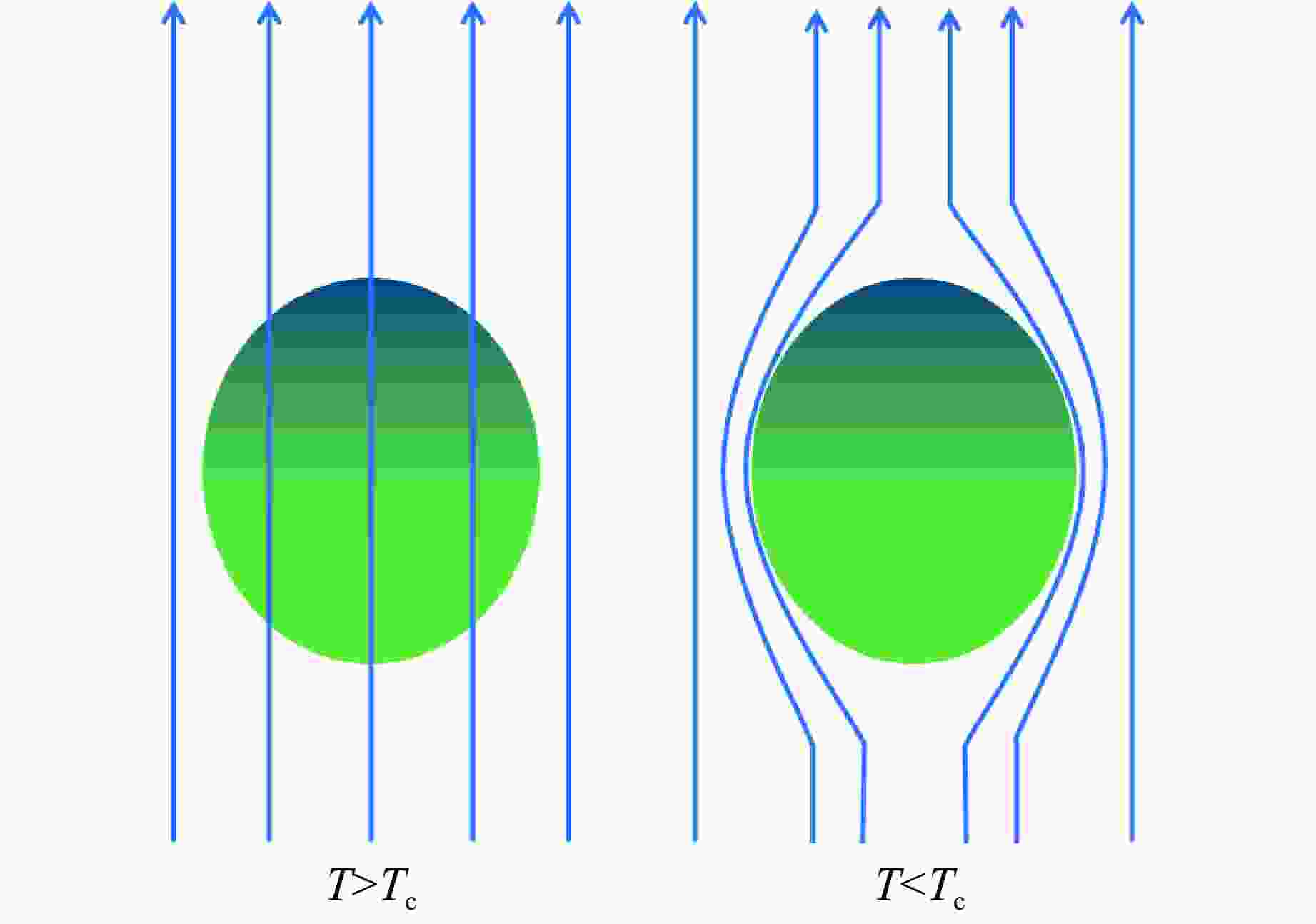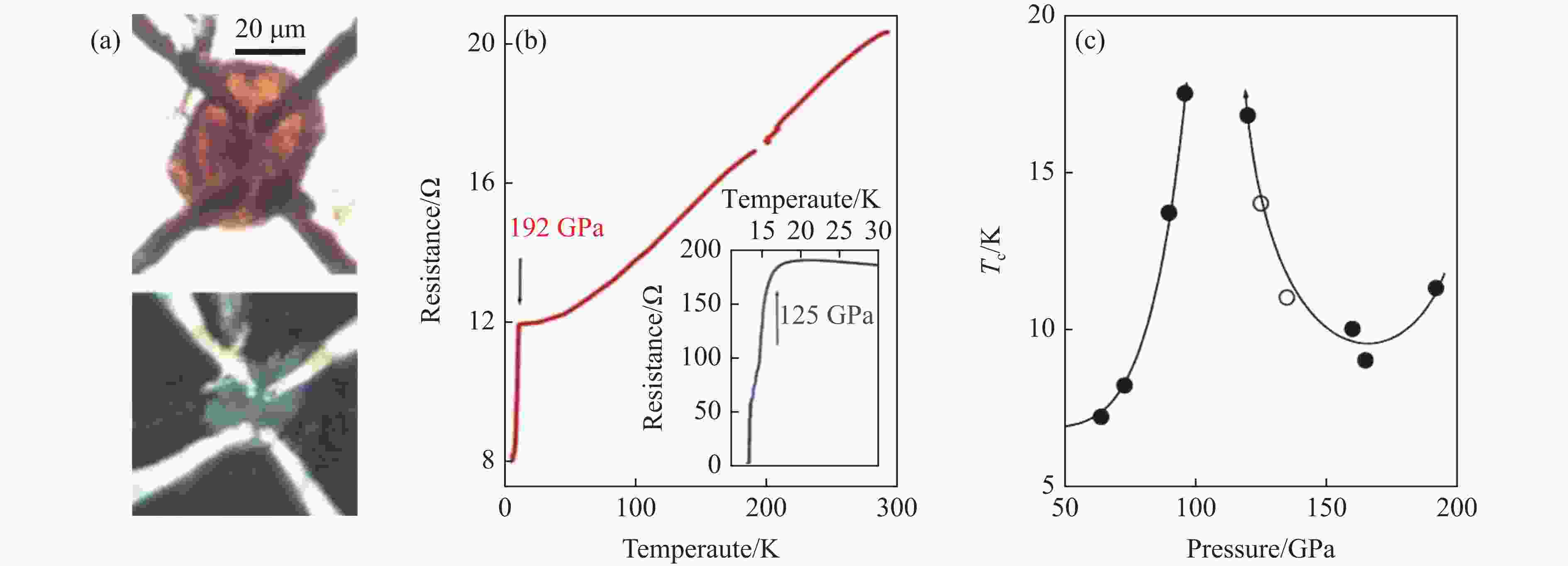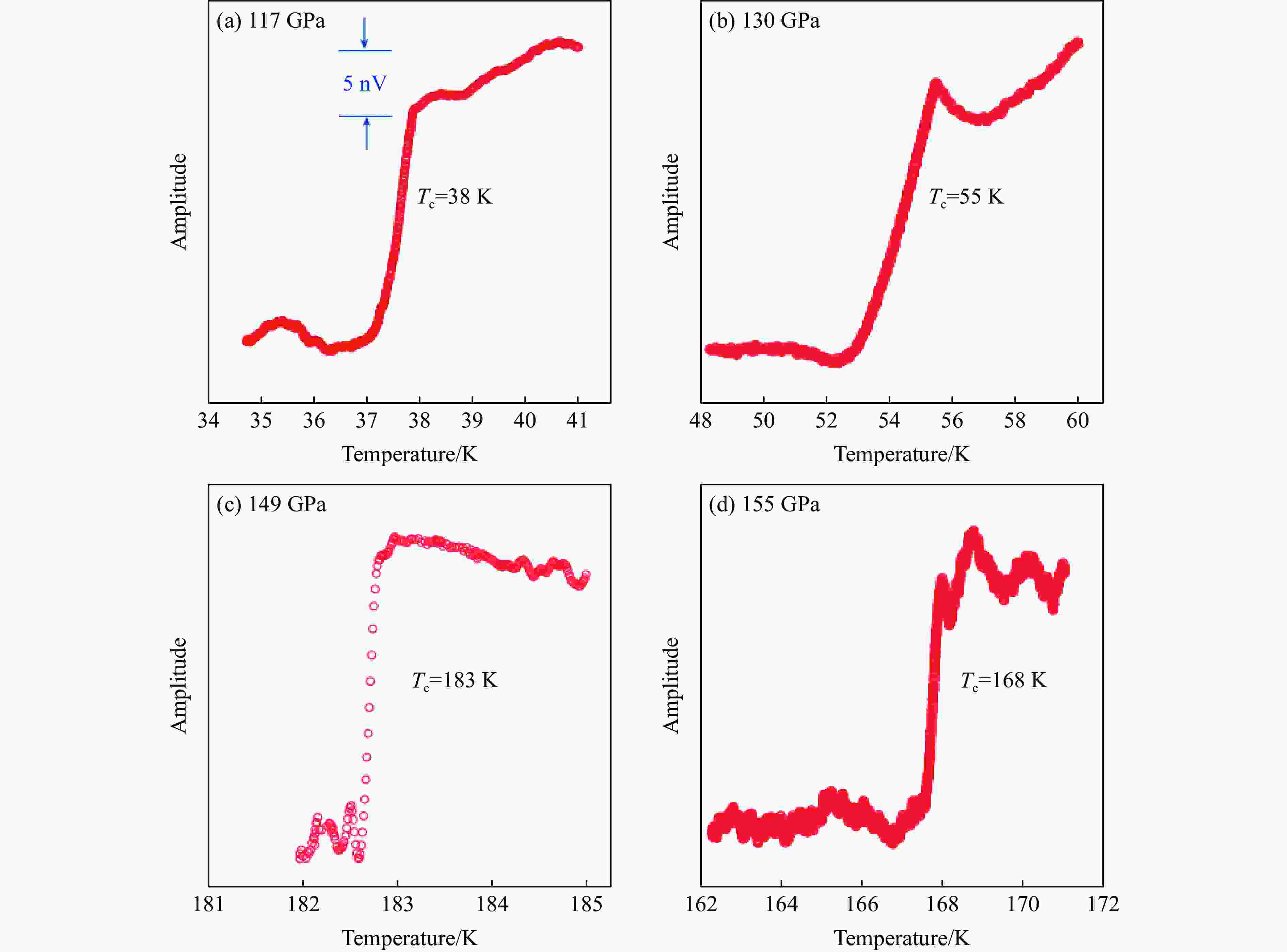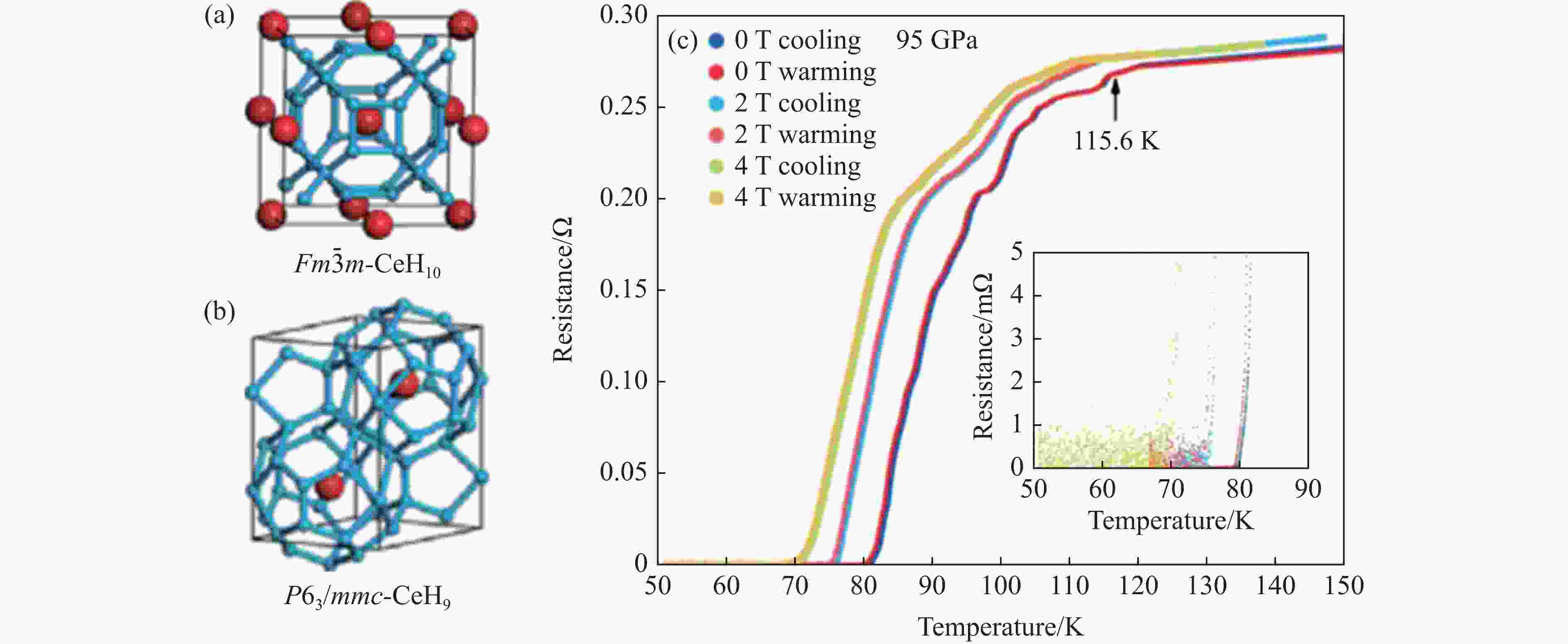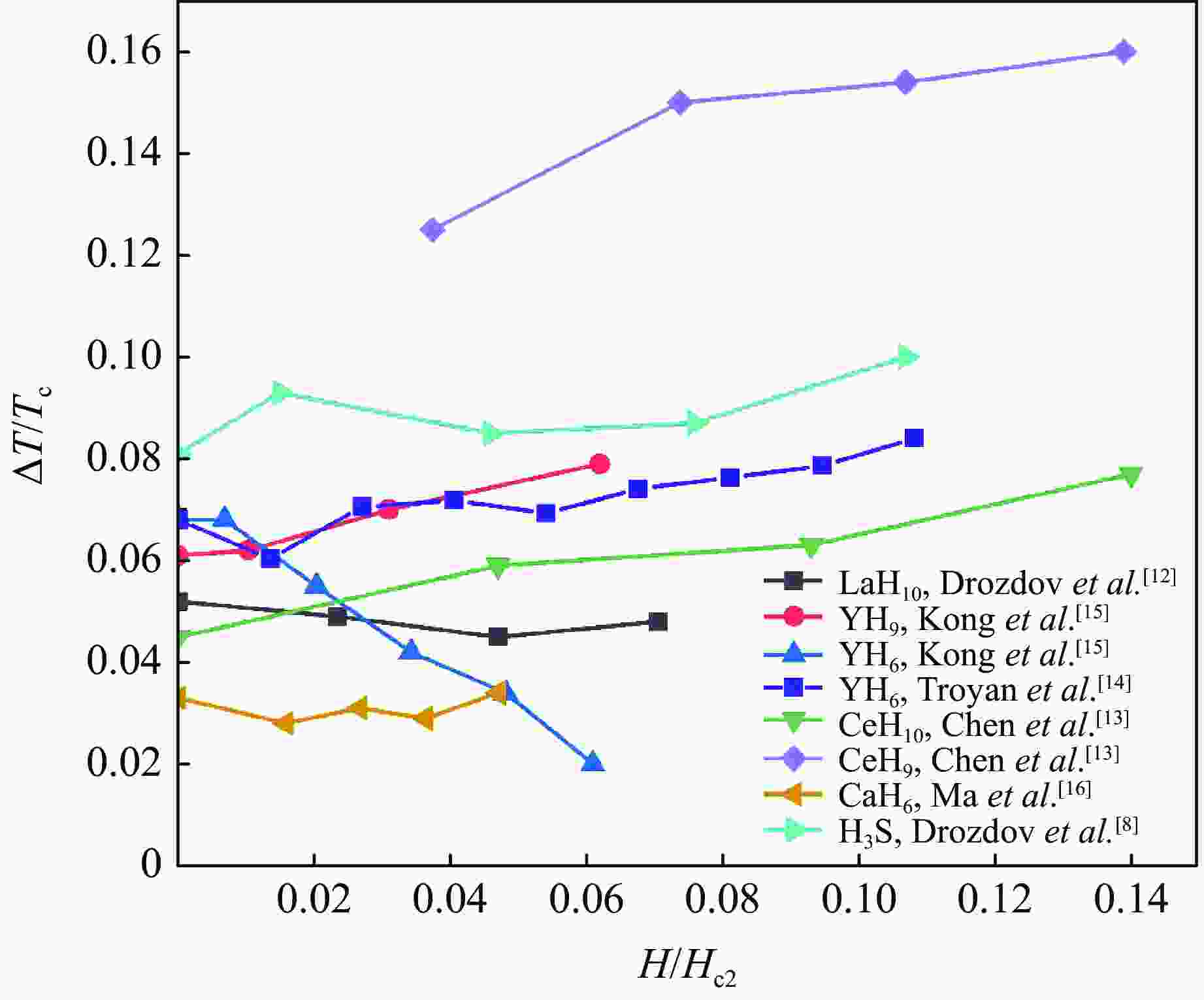Progress of Experimental Research on Binary Hydride Superconductors under High Pressure
-
摘要: 自从1911年著名物理学家Onnes发现超导电性以来,人们不断努力提高超导转变温度,室温超导体是人类追逐的百年梦想。在近百年的研究历程中,铜基超导体、铁基超导体及麦克米兰极限MgB2超导体的发现不断刷新了人们对超导领域的认知,也增强了人们进一步提高超导转变温度和挖掘高温超导机制的信心。最近,理论预测并被实验验证的新型富氢化合物显示了高温乃至室温超导电性的巨大潜力,成为室温超导体的最佳候选体系之一。值得注意的是,高压下硫氢化物和镧氢化物均具有超过200 K的超导转变温度,引领了富氢化合物的研究热潮,涌现了一些重要的理论和实验成果。本文聚焦于目前富氢化合物超导体的实验研究进展,从不同氢结构单元及氢成键特征的角度总结和归纳新型富氢化合物的晶体结构性质及超导性能。主要介绍了5种在实验上成功获得的富氢化合物超导体:间隙型、离子型、共价型、笼型及分子型。通过对比分析不同类型的富氢化合物超导体,总结出一些影响超导转变温度的普适规律,并提出目前实验上亟待解决的问题和未来主攻的实验方向。Abstract: Since the discovery of superconductivity by the famous physicist Onnes in 1911, people have constantly tried to improve the superconducting transition temperature, and the room-temperature superconductors have also been a century-old dream of human beings. In the course of nearly a hundred years of research, it has constantly updated people’s understanding of superconductivity, enhanced people’s confidence in further improving the superconducting transition temperature and exploring the mechanism of high temperature superconductivity that scientists have discovered copper based superconductors, iron based superconductors and McMillan limit superconductors (like MgB2). Recently, new hydrogen-rich compounds predicted theoretically and verified experimentally have shown great potential for high temperature superconductivity even room temperature superconductivity, becoming one of the best candidates for room temperature superconductors. It is worth noting that some sulfur hydrides and lanthanum hydrides have superconductivity of more than 200 K under high pressure, leading a research boom of hydrogen-rich compounds and some important theoretical and experimental results have emerged. This paper focuses on the current research progress of hydrogen-rich superconductors, summarizes the crystal structure properties and superconducting properties of new hydrogen-rich compounds from the perspective of different hydrogen structural units and hydrogen bonding characteristics. Five kinds of superconductors in hydrogen-rich compounds are introduced in this paper: interstitial type, ionic type, covalent type, cage type and molecular type, and some general rules affecting the superconducting transition temperature are summarized through comparative analysis of different types of hydrogen-rich compound superconductors. In the end, the current experimental problems to be solved and the future experimental direction are put forward.
-
图 6 (a) 恒压退火过程中电阻与温度的关系,(b) 高压下硫化氢和硫化氘电阻与温度的关系,(c) H3S的超导转变温度随压力的变化[8]
Figure 6. (a) Dependence of resistance to temperature in constant pressure annealing process; (b) critical temperature of sulfur hydride and sulfur deuteride at high pressure; (c) dependence of superconducting temperature with pressure for H3S[8]
图 8 (a) 40 GPa下Zr-H样品的电阻-温度变化曲线(插图为激光加热后的样品腔),(b) 40 GPa下超导转变温度随外加磁场的变化,(c)~(d) 分别用WHH与GL方程外推拟合上临界磁场[69]
Figure 8. (a) R-T curve for Zr-H sample at 40 GPa (The sample chamber is presented in inset); (b) superconductingtemperature under applied magnetic fields at 40 GPa; (c)–(d) upper critical magnetic fieldswhich extrapolated by GL and WHH equations, respectively[69]
图 9 (a)立方相LaH10的氢笼结构[78],(b) Somayazulu等[73]合成的LaH10的电阻随温度的变化,(c) Drozdov等[12]合成的LaH10的电阻随压力的变化,(d) Huang等[76]外加磁场作用下LaH10的转变温度
Figure 9. (a) Clathrate structure of LaH10[78]; (b) the superconducting critical temperature of LaH10 reported by Somayazulu et al.[73];(c) the dependence of Tc with pressure for LaH10 synthesized by Drozdov et al.[12]; (d) the critical temperature forLaH10 under applied magnetic fields reported by Huang et al.[76]
表 1 不同课题组关于H3S体系的超导电性研究[8–9, 54, 57–59]
Table 1. Superconductivity of H3S reported by several groups[8–9, 54, 57–59]
Groups Sample synthesis Tc/K Corresponding
pressure/GPaStructure of
superconducting phasesDrozdov et al.[8] Loading H2S gas at low temperature 203 155 Undetermined Huang et al.[9] Loading H2S gas at low temperature 183 149 Calculation: Im$ \overline{3} $m-H3S Einaga et al.[55] Loading H2S gas at low temperature 200 150 XRD: Im$ \overline{3} $m-H3S Goncharov et al.[57] Laser heated pure S and hydrogen Unmeasured Unmeasured XRD: Cccm-H3S@50 GPa,
R3m-H3S@70 GPa,
Im$ \overline{3} $m-H3S@140 GPaCapitani et al.[58] Loading H2S gas at low temperature 200 150 Undetermined Troyan et al.[59] Loading H2S gas at low temperature 140 153 Undetermined 表 2 实验合成的典型笼型氢化物超导体[12–17, 72–73]
Table 2. Typical clathrate hydride superconductors synthesized in experiment[12–17, 72–73]
Sample Space group Pressure/GPa Tc/K Mensurement method LaH10 Fm$ \overline{3} $m 170 250 XRD ThH10 Fm$ \overline{3} $m 170 161 XRD YH6 Im$ \overline{3} $m 183 220 XRD YH9 P63/mmc 201 243 XRD CeH9 P63/mmc 130 100 XRD CeH10 Fm$ \overline{3} $m 95 115 XRD CaH6 Im$ \overline{3} $m 172 215 XRD 表 3 钇超氢化物合成条件及超导转变温度
Table 3. Superconducting critical temperature of yttrium superhydrides
Samples Ref. Space
groupsPressures/
GPaTc/K Reactants Synthetic methods YH6 Troyan
et al.[14]Im$ \overline{3} $m 166 224 Y+NH3BH3 Laser heated to 2400 K at high pressure Kong
et al.[15]Im$ \overline {3}$m 237 208.5 YH3+H2 Kept the sample for three weeks under high pressure 183 220 Y+H2 Laser heated to 1500 K at high pressure 159 220 YH3+H2 Increased the sample to 201 GPa for one month
and laser heated the sample to 2000 KYH9 Snider
et al.[72]P63/mmc 182±8 262 Y+H2 Pressured the Y metal wrapped by Pd film and hydrogen to
over 130 GPa and laser heated the sample to 1800 KKong
et al.[15]P63/mmc 237 227 YH3+H2 Maintained the sample for three weeks 237 237 YH3+H2 Maintained the sample for three weeks and
laser heated sample to 700 K201 243 YH3+H2 Maintained the sample for one month
and laser heated sample to 2000 KYH4 Shao
et al.[81]I4/mmm 155 88 YH2+NH3BH3 Increased the pressure to about 150 GPa
and laser heated sample to 1500 K表 4 理论预测的近室温或超室温二元、三元富氢化合物超导体
Table 4. Theoretical prediction of binary and ternary polyhydrides with high-temperature superconductivity
Type Samples Space
groupsPressure/
GPaTc/K Features Binary hydride
superconductorsAcH10[97] R$ \overline{3} $m 200 204–251 Both are predicted to be phonon-mediated superconductors
with an almost empty layer of d atomsAcH16[97] P$ \overline{6} $m2 150 199–241 TbH9[98] C2/c 230 220 With a typical hydrogen cage structure, the coupling of
electrons and hydrogen phonons in the Tb-4f layer
plays a key role in superconductivityTbH10[98] R$ \overline{3} $m 270 270 TbH10[98] Fm$ \overline{3} $m 230 270 ZrH10[96] P63/mmc 250 220 Lamellar alkene H10 junction H3S0.925P0.075[99] Fm$ \overline{3} $m 250 280 Doping calculation based on H3S H3S0.96Si0.04[99] Fm$ \overline{3} $m 250 274 SrH6[100] R$ \overline{3} $m 150 220–235 Hydrogen atoms are clathratelike and form twisted chains SrH10[101] Cmca 300 259 Hydrogen atoms are distributed in staggered
two-dimensional honeycomb layersMgH6[102] Im$ \overline{3} $m 300 420 YH10[10–11, 103] Im$ \overline{3} $m 250 305–326 Unique H32 cagelike structure YH10[10–11, 103] Im$ \overline{3} $m 400 303 YH10[10–11, 103] Im$ \overline{3} $m 300 310 Ternary hydride
superconductorsLi2MgH16[104] Fd$ \overline{3} $m 250 473 Wang et al.[105] pointed that the diffusion of protons between
interstitial spaces may play a key roleCaHfH12[104] Pm$ \overline{3} $m 300 360 The metal skeleton material should be composed of a metal
element with an effective optimal valency of 3, and the metal
should occupy a volume of about 0.4 in the hydrideCaZrH12[106] Pm$ \overline{3} $m 200 290 Mg0.5Ca0.5H6[107] Im$ \overline{3} $m 200 288 Y3CaH24[108] Fm$ \overline{3} $m 150 250 Y3LuH24[109] Fm$ \overline{3} $m 120 283 YLu3H24[109] Fm$ \overline{3} $m 110 288 YLuH12[109] Fd$ \overline{3} $m 140 275 -
[1] ONNES H K. The superconductivity of mercury [J]. Comm Phys Lab Univ Leiden, 1911, 122: 122–124. [2] GAO L, XUE Y Y, CHEN F, et al. Superconductivity up to 164 K in HgBa2Ca m -1Cu m O2 m +2+ δ ( m=1, 2, and 3) under quasihydrostatic pressures [J]. Physical Review B, 1994, 50(6): 4260–4263. doi: 10.1103/PhysRevB.50.4260 [3] BARDEEN J, COOPER L N, SCHRIEFFER J R. Theory of superconductivity [J]. Physical Review, 1957, 108(5): 1175–1204. doi: 10.1103/PhysRev.108.1175 [4] ASHCROFT N W. Metallic hydrogen: a high-temperature superconductor? [J]. Physical Review Letters, 1968, 21(26): 1748–1749. doi: 10.1103/PhysRevLett.21.1748 [5] MCMAHON J M, CEPERLEY D M. High-temperature superconductivity in atomic metallic hydrogen [J]. Physical Review B, 2011, 84(14): 144515. doi: 10.1103/PhysRevB.84.144515 [6] ASHCROFT N W. Hydrogen dominant metallic alloys: high temperature superconductors? [J]. Physical Review Letters, 2004, 92(18): 187002. doi: 10.1103/PhysRevLett.92.187002 [7] DUAN D F, LIU Y X, TIAN F B, et al. Pressure-induced metallization of dense (H2S)2H2 with high- Tc superconductivity [J]. Scientific Reports, 2014, 4(1): 6968. doi: 10.1038/srep06968 [8] DROZDOV A P, EREMETS M I, TROYAN I A, et al. Conventional superconductivity at 203 kelvin at high pressures in the sulfur hydride system [J]. Nature, 2015, 525(7567): 73–76. doi: 10.1038/nature14964 [9] HUANG X L, WANG X, DUAN D F, et al. High-temperature superconductivity in sulfur hydride evidenced by alternating-current magnetic susceptibility [J]. National Science Review, 2019, 6(4): 713–718. doi: 10.1093/nsr/nwz061 [10] LIU H Y, NAUMOV I I, HOFFMANN R, et al. Potential high- Tc superconducting lanthanum and yttrium hydrides at high pressure [J]. Proceedings of the National Academy of Sciences of the United States of America, 2017, 114(27): 6990–6995. doi: 10.1073/pnas.1704505114 [11] PENG F, SUN Y, PICKARD C J, et al. Hydrogen clathrate structures in rare earth hydrides at high pressures: possible route to room-temperature superconductivity [J]. Physical Review Letters, 2017, 119(10): 107001. doi: 10.1103/PhysRevLett.119.107001 [12] DROZDOV A P, KONG P P, MINKOV V S, et al. Superconductivity at 250 K in lanthanum hydride under high pressures [J]. Nature, 2019, 569(7757): 528–531. doi: 10.1038/s41586-019-1201-8 [13] CHEN W H, SEMENOK D V, HUANG X L, et al. High-temperature superconducting phases in cerium superhydride with a Tc up to 115 K below a pressure of 1 megabar [J]. Physical Review Letters, 2021, 127(11): 117001. doi: 10.1103/PhysRevLett.127.117001 [14] TROYAN I A, SEMENOK D V, KVASHNIN A G, et al. Anomalous high-temperature superconductivity in YH6 [J]. Advanced Materials, 2021, 33(15): 2006832. doi: 10.1002/adma.202006832 [15] KONG P P, MINKOV V S, KUZOVNIKOV M A, et al. Superconductivity up to 243 K in the yttrium-hydrogen system under high pressure [J]. Nature Communications, 2021, 12(1): 5075. doi: 10.1038/s41467-021-25372-2 [16] MA L, WANG K, XIE Y, et al. High-temperature superconducting phase in clathrate calcium hydride CaH6 up to 215 K at a pressure of 172 GPa [J]. Physical Review Letters, 2022, 128(16): 167001. doi: 10.1103/PhysRevLett.128.167001 [17] SEMENOK D V, KVASHNIN A G, IVANOVA A G, et al. Superconductivity at 161 K in thorium hydride ThH10: synthesis and properties [J]. Materials Today, 2020, 33: 36–44. doi: 10.1016/j.mattod.2019.10.005 [18] NAGAMATSU J, NAKAGAWA N, MURAMATSU T, et al. Superconductivity at 39 K in magnesium diboride [J]. Nature, 2001, 410(6824): 63–64. doi: 10.1038/35065039 [19] REN Z A, LU W, YANG J, et al. Superconductivity at 55 K in iron-based f-doped layered quaternary compound Sm[O1 − x F x ] FeAs [J]. Chinese Physics Letters, 2008, 25(6): 2215–2216. doi: 10.1088/0256-307X/25/6/080 [20] KIHLSTROM K E, MAEL D, GEBALLE T H. Tunneling α2 F( ω) and heat-capacity measurements in high- Tc Nb3Ge [J]. Physical Review B, 1984, 29(1): 150–158. doi: 10.1103/PhysRevB.29.150 [21] GUO J N, SHUTOV G, CHEN S, et al. Stabilization of high-temperature superconducting A15 phase La4H23 below 100 GPa [EB/OL]. arXiv: 2307.13067. (2023-11-20)[2023-09-27]. https://arxiv.org/abs/2307.13067v1. [22] LI X, HUANG X L, DUAN D F, et al. Polyhydride CeH9 with an atomic-like hydrogen clathrate structure [J]. Nature Communications, 2019, 10(1): 3461. doi: 10.1038/s41467-019-11330-6 [23] ROTUNDU C R, ĆUK T, GREENE R L, et al. High-pressure resistivity technique for quasi-hydrostatic compression experiments [J]. Review of Scientific Instruments, 2013, 84(6): 063903. doi: 10.1063/1.4809025 [24] MINKOV V S, BUD’KO S L, BALAKIREV F F, et al. Magnetic field screening in hydrogen-rich high-temperature superconductors [J]. Nature Communications, 2022, 13(1): 3194. doi: 10.1038/s41467-022-30782-x [25] MINKOV V S, KSENOFONTOV V, BUD’KO S L, et al. Magnetic flux trapping in hydrogen-rich high-temperature superconductors [J]. Nature Physics, 2023, 19(9): 1293–1300. doi: 10.1038/s41567-023-02089-1 [26] 黄晓丽, 王鑫, 刘明坤, 等. 极端条件下物质磁性的原位测量 [J]. 物理学报, 2017, 66(3): 037403. doi: 10.7498/aps.66.037403HUANG X L, WANG X, LIU M K, et al. In-situ magnetic measurements of substances under extreme conditions [J]. Acta Physica Sinica, 2017, 66(3): 037403. doi: 10.7498/aps.66.037403 [27] WORSHAM J E JR, WILKINSON M K, SHULL C G. Neutron-diffraction observations on the palladium-hydrogen and palladium-deuterium systems [J]. Journal of Physics and Chemistry of Solids, 1957, 3(3/4): 303–310. doi: 10.1016/0022-3697(57)90033-1 [28] KAWAE T, INAGAKI Y, WEN S, et al. Superconductivity in palladium hydride systems [J]. Journal of the Physical Society of Japan, 2020, 89(5): 051004. doi: 10.7566/JPSJ.89.051004 [29] SCHIRBER J E, NORTHRUP C J M JR. Concentration dependence of the superconducting transition temperature in PdH x and PdD x [J]. Physical Review B, 1974, 10(9): 3818–3820. doi: 10.1103/PhysRevB.10.3818 [30] HEMMES H, DRIESSEN A, GRIESSEN R, et al. Isotope effects and pressure dependence of the Tc of superconducting stoichiometric PdH and PdD synthesized and measured in a diamond anvil cell [J]. Physical Review B, 1989, 39(7): 4110–4118. doi: 10.1103/PhysRevB.39.4110 [31] SKOSKIEWICZ T. Superconductivity in the palladium-hydrogen and palladium-nickel-hydrogen systems [J]. Physica Status Solidi (A), 1972, 11(2): K123–K126. doi: 10.1002/pssa.2210110253 [32] STRITZKER B, BUCKEL W. Superconductivity in the palladium-hydrogen and the palladium-deuterium systems [J]. Zeitschrift für Physik a Hadrons and Nuclei, 1972, 257(1): 1–8. doi: 10.1007/BF01398191 [33] TRIPODI P, DI GIOACCHINO D, BORELLI R, et al. Possibility of high temperature superconducting phases in PdH [J]. Physica C: Superconductivity, 2003, 388/389: 571–572. doi: 10.1016/S0921-4534(02)02745-4 [34] KLEIN B M, ECONOMOU E N, PAPACONSTANTOPOULOS D A. Inverse isotope effect and the x dependence of the superconducting transition temperature in PdH x and PdD x [J]. Physical Review Letters, 1977, 39(9): 574–577. doi: 10.1103/PhysRevLett.39.574 [35] JENA P, JONES J, NIEMINEN R M. Effect of zero-point motion on the superconducting transition temperature of PdH(D) [J]. Physical Review B, 1984, 29(7): 4140–4143. doi: 10.1103/PhysRevB.29.4140 [36] MILLER R J, SATTERTHWAITE C B. Electronic model for the reverse isotope effect in superconducting Pd-H(D) [J]. Physical Review Letters, 1975, 34(3): 144–148. doi: 10.1103/PhysRevLett.34.144 [37] KLEIN B M, COHEN R E. Anharmonicity and the inverse isotope effect in the palladium-hydrogen system [J]. Physical Review B, 1992, 45(21): 12405–12414. doi: 10.1103/PhysRevB.45.12405 [38] ERREA I, CALANDRA M, MAURI F. First-principles theory of anharmonicity and the inverse isotope effect in superconducting palladium-hydride compounds [J]. Physical Review Letters, 2013, 111(17): 177002. doi: 10.1103/PhysRevLett.111.177002 [39] KIM D Y, SCHEICHER R H, PICKARD C J, et al. Predicted formation of superconducting platinum-hydride crystals under pressure in the presence of molecular hydrogen [J]. Physical Review Letters, 2011, 107(11): 117002. doi: 10.1103/PhysRevLett.107.117002 [40] SCHELER T, DEGTYAREVA O, MARQUÉS M, et al. Synthesis and properties of platinum hydride [J]. Physical Review B, 2011, 83(21): 214106. doi: 10.1103/PhysRevB.83.214106 [41] MATSUOKA T, HISHIDA M, KUNO K, et al. Superconductivity of platinum hydride [J]. Physical Review B, 2019, 99(14): 144511. doi: 10.1103/PhysRevB.99.144511 [42] ABE K. Metallic silicon subhydrides at high pressures studied by ab initio calculations [J]. Physical Review B, 2021, 103(13): 134118. doi: 10.1103/PhysRevB.103.134118 [43] MARTINEZ-CANALES M, OGANOV A R, MA Y M, et al. Novel structures and superconductivity of silane under pressure [J]. Physical Review Letters, 2009, 102(8): 087005. doi: 10.1103/PhysRevLett.102.087005 [44] PICKARD C J, NEEDS R J. High-pressure phases of silane [J]. Physical Review Letters, 2006, 97(4): 045504. doi: 10.1103/PhysRevLett.97.045504 [45] STROBEL T A, GONCHAROV A F, SEAGLE C T, et al. High-pressure study of silane to 150 GPa [J]. Physical Review B, 2011, 83(14): 144102. doi: 10.1103/PhysRevB.83.144102 [46] FENG J, GROCHALA W, JAROŃ T, et al. Structures and potential superconductivity in SiH4 at high pressure: en route to “metallic hydrogen” [J]. Physical Review Letters, 2006, 96(1): 017006. doi: 10.1103/PhysRevLett.96.017006 [47] HANFLAND M, PROCTOR J E, GUILLAUME C L, et al. High-pressure synthesis, amorphization, and decomposition of silane [J]. Physical Review Letters, 2011, 106(9): 095503. doi: 10.1103/PhysRevLett.106.095503 [48] EREMETS M I, TROJAN I A, MEDVEDEV S A, et al. Superconductivity in hydrogen dominant materials: silane [J]. Science, 2008, 319(5869): 1506–1509. doi: 10.1126/science.1153282 [49] TSE J S, YAO Y, TANAKA K. Novel superconductivity in metallic SnH4 under high pressure [J]. Physical Review Letters, 2007, 98(11): 117004. doi: 10.1103/PhysRevLett.98.117004 [50] HONG F, SHAN P F, YANG L X, et al. Possible superconductivity at ~70 K in tin hydride SnH x under high pressure [J]. Materials Today Physics, 2022, 22: 100596. doi: 10.1016/j.mtphys.2021.100596 [51] TROYAN I A, SEMENOK D V, IVANOVA A G, et al. Non-fermi-liquid behavior of superconducting SnH4 [J]. Advanced Science, 2023, 10(30): 2303622. doi: 10.1002/advs.202303622 [52] WANG L C, TIAN F B, FENG W X, et al. Order-disorder phase transition and dissociation of hydrogen sulfide under high pressure: ab initio molecular dynamics study [J]. The Journal of Chemical Physics, 2010, 132(16): 164506. doi: 10.1063/1.3392673 [53] LI Y W, HAO J, LIU H Y, et al. The metallization and superconductivity of dense hydrogen sulfide [J]. The Journal of Chemical Physics, 2014, 140(17): 174712. doi: 10.1063/1.4874158 [54] FUJIHISA H, YAMAWAKI H, SAKASHITA M, et al. Molecular dissociation and two low-temperature high-pressure phases of H2S [J]. Physical Review B, 2004, 69(21): 214102. doi: 10.1103/PhysRevB.69.214102 [55] EINAGA M, SAKATA M, ISHIKAWA T, et al. Crystal structure of the superconducting phase of sulfur hydride [J]. Nature Physics, 2016, 12(9): 835–838. doi: 10.1038/nphys3760 [56] GUIGUE B, MARIZY A, LOUBEYRE P. Direct synthesis of pure H3S from S and H elements: no evidence of the cubic superconducting phase up to 160 GPa [J]. Physical Review B, 2017, 95(2): 020104. doi: 10.1103/PhysRevB.95.020104 [57] GONCHAROV A F, LOBANOV S S, PRAKAPENKA V B, et al. Stable high-pressure phases in the H-S system determined by chemically reacting hydrogen and sulfur [J]. Physical Review B, 2017, 95(14): 140101. doi: 10.1103/PhysRevB.95.140101 [58] CAPITANI F, LANGEROME B, BRUBACH J B, et al. Spectroscopic evidence of a new energy scale for superconductivity in H3S [J]. Nature Physics, 2017, 13(9): 859–863. doi: 10.1038/nphys4156 [59] TROYAN I, GAVRILIUK A, RÜFFER R, et al. Observation of superconductivity in hydrogen sulfide from nuclear resonant scattering [J]. Science, 2016, 351(6279): 1303–1306. doi: 10.1126/science.aac8176 [60] SATTERTHWAITE C B, PETERSON D T. Preparation, electrical and superconducting properties of massive Th4H15 [J]. Journal of the Less Common Metals, 1972, 26(3): 361–368. doi: 10.1016/0022-5088(72)90085-9 [61] SHEIN I R, SHEIN K I, MEDVEDEVA N I, et al. Electronic band structure of thorium hydrides: ThH2 and Th4H15 [J]. Physica B: Condensed Matter, 2007, 389(2): 296–301. doi: 10.1016/j.physb.2006.07.001 [62] TALANTSEV E F. The electron-phonon coupling constant and the Debye temperature in polyhydrides of thorium, hexadeuteride of yttrium, and metallic hydrogen phase Ⅲ [J]. Journal of Applied Physics, 2021, 130(19): 195901. doi: 10.1063/5.0065003 [63] WANG N N, SHAN P F, CHEN K Y, et al. A low- Tc superconducting modification of Th4H15 synthesized under high pressure [J]. Superconductor Science and Technology, 2021, 34(3): 034006. doi: 10.1088/1361-6668/abdcc2 [64] SATTERTHWAITE C B, TOEPKE I L. Superconductivity of hydrides and deuterides of thorium [J]. Physical Review Letters, 1970, 25(11): 741–743. doi: 10.1103/PhysRevLett.25.741 [65] MILLER J F, CATON R H, SATTERTHWAITE C B. Low-temperature heat capacity of normal and superconducting thorium hydride and thorium deuteride [J]. Physical Review B, 1976, 14(7): 2795–2800. doi: 10.1103/PhysRevB.14.2795 [66] DIETRICH M, REICHARDT W, RIETSCHEL H. Phonon densities of states of the thorium hydrides [J]. Solid State Communications, 1977, 21(6): 603–605. doi: 10.1016/0038-1098(77)90043-6 [67] DIETRICH M, GEY W, RIETSCHEL H, et al. Pressure dependence of the superconducting transition temperature of Th4H15 [J]. Solid State Communications, 1974, 15(5): 941–943. doi: 10.1016/0038-1098(74)90699-1 [68] KUZOVNIKOV M A, TKACZ M. High-pressure synthesis of novel polyhydrides of Zr and Hf with a Th4H15-type structure [J]. The Journal of Physical Chemistry C, 2019, 123(50): 30059–30066. doi: 10.1021/acs.jpcc.9b07918 [69] XIE H, ZHANG W T, DUAN D F, et al. Superconducting zirconium polyhydrides at moderate pressures [J]. The Journal of Physical Chemistry Letters, 2020, 11(3): 646–651. doi: 10.1021/acs.jpclett.9b03632 [70] ZHANG C L, HE X, LI Z W, et al. Superconductivity in zirconium polyhydrides with Tc above 70 K [J]. Science Bulletin, 2022, 67(9): 907–909. doi: 10.1016/j.scib.2022.03.001 [71] ABE K. High-pressure properties of dense metallic zirconium hydrides studied by ab initio calculations [J]. Physical Review B, 2018, 98(13): 134103. doi: 10.1103/PhysRevB.98.134103 [72] SNIDER E, DASENBROCK-GAMMON N, MCBRIDE R, et al. Synthesis of yttrium superhydride superconductor with a transition temperature up to 262 K by catalytic hydrogenation at high pressures [J]. Physical Review Letters, 2021, 126(11): 117003. doi: 10.1103/PhysRevLett.126.117003 [73] SOMAYAZULU M, AHART M, MISHRA A K, et al. Evidence for superconductivity above 260 K in lanthanum superhydride at megabar pressures [J]. Physical Review Letters, 2019, 122(2): 027001. doi: 10.1103/PhysRevLett.122.027001 [74] HONG F, YANG L X, SHAN P F, et al. Superconductivity of lanthanum superhydride investigated using the standard four-probe configuration under high pressures [J]. Chinese Physics Letters, 2020, 37(10): 107401. doi: 10.1088/0256-307X/37/10/107401 [75] SUN D, MINKOV V S, MOZAFFARI S, et al. High-temperature superconductivity on the verge of a structural instability in lanthanum superhydride [J]. Nature Communications, 2021, 12(1): 6863. doi: 10.1038/s41467-021-26706-w [76] GUO J N, CHEN S, CHEN W H, et al. Advances in the synthesis and superconductivity of lanthanide polyhydrides under high pressure [J]. Frontiers in Electronic Materials, 2022, 2: 906213. doi: 10.3389/femat.2022.906213 [77] ABD-SHUKOR R. Coherence length versus transition temperature of hydride-based and room temperature superconductors [J]. Results in Physics, 2021, 25: 104219. doi: 10.1016/j.rinp.2021.104219 [78] GE Y F, ZHANG F, HEMLEY R J. Room-temperature superconductivity in boron- and nitrogen-doped lanthanum superhydride [J]. Physical Review B, 2021, 104(21): 214505. doi: 10.1103/PhysRevB.104.214505 [79] KVASHNIN A G, SEMENOK D V, KRUGLOV I A, et al. High-temperature superconductivity in a Th-H system under pressure conditions [J]. ACS Applied Materials & Interfaces, 2018, 10(50): 43809–43816. doi: 10.1021/acsami.8b17100 [80] LI Y W, HAO J, LIU H Y, et al. Pressure-stabilized superconductive yttrium hydrides [J]. Scientific Reports, 2015, 5: 9948. doi: 10.1038/srep09948 [81] SHAO M Y, CHEN W H, ZHANG K X, et al. High-pressure synthesis of superconducting clathratelike YH4 [J]. Physical Review B, 2021, 104(17): 174509. doi: 10.1103/PhysRevB.104.174509 [82] GRIESSEN R, WEN H H, VAN DALEN A J J, et al. Evidence for mean free path fluctuation induced pinning in YBa2Cu3O7 and YBa2Cu4O8 films [J]. Physical Review Letters, 1994, 72(12): 1910–1913. doi: 10.1103/PhysRevLett.72.1910 [83] LI B, MIAO Z L, TI L, et al. Predicted high-temperature superconductivity in cerium hydrides at high pressures [J]. Journal of Applied Physics, 2019, 126(23): 235901. doi: 10.1063/1.5130583 [84] LI X, HUANG X L, CHEN W H, et al. New cage-like cerium trihydride stabilized at ambient conditions [J]. CCS Chemistry, 2022, 4(3): 825–831. doi: 10.31635/ccschem.021.202100799 [85] SALKE N P, DAVARI ESFAHANI M M, ZHANG Y J, et al. Synthesis of clathrate cerium superhydride CeH9 at 80−100 GPa with atomic hydrogen sublattice [J]. Nature Communications, 2019, 10(1): 4453. doi: 10.1038/s41467-019-12326-y [86] WANG H, TSE J S, TANAKA K, et al. Superconductive sodalite-like clathrate calcium hydride at high pressures [J]. Proceedings of the National Academy of Sciences of the United States of America, 2012, 109(17): 6463–6466. doi: 10.1073/pnas.1118168109 [87] LI Z W, HE X, ZHANG C L, et al. Superconductivity above 200 K discovered in superhydrides of calcium [J]. Nature Communications, 2022, 13(1): 2863. doi: 10.1038/s41467-022-30454-w [88] CHEN W H, SEMENOK D V, KVASHNIN A G, et al. Synthesis of molecular metallic barium superhydride: pseudocubic BaH12 [J]. Nature Communications, 2021, 12(1): 273. doi: 10.1038/s41467-020-20103-5 [89] LUO W, AHUJA R. Ab initio prediction of high-pressure structural phase transition in BaH2 [J]. Journal of Alloys and Compounds, 2007, 446/447: 405–408. doi: 10.1016/j.jallcom.2006.12.103 [90] HOOPER J, ALTINTAS B, SHAMP A, et al. Polyhydrides of the alkaline earth metals: a look at the extremes under pressure [J]. The Journal of Physical Chemistry C, 2013, 117(6): 2982–2992. doi: 10.1021/jp311571n [91] TSE J S, SONG Z, YAO Y S, et al. Structure and electronic properties of BaH2 at high pressure [J]. Solid State Communications, 2009, 149(43/44): 1944–1946. doi: 10.1016/j.ssc.2009.07.044 [92] ZHANG X, WANG X L, WANG Q L, et al. Hydride ion (H−) transport behavior in barium hydride under high pressure [J]. Physical Chemistry Chemical Physics, 2018, 20(13): 8917–8923. doi: 10.1039/C7CP08386F [93] PEÑA-ALVAREZ M, BINNS J, MARTINEZ-CANALES M, et al. Synthesis of weaire-phelan barium polyhydride [J]. The Journal of Physical Chemistry Letters, 2021, 12(20): 4910–4916. doi: 10.1021/acs.jpclett.1c00826 [94] SEMENOK D V, CHEN W H, HUANG X L, et al. Sr-doped superionic hydrogen glass: synthesis and properties of SrH22 [J]. Advanced Materials, 2022, 34(27): 2200924. doi: 10.1002/adma.202200924 [95] BHATTACHARYYA P, CHEN W, HUANG X, et al. Imaging the meissner effect in hydride superconductors using quantum sensors [J]. Nature, 2024, 627(8002): 73–79. [96] XIE H, YAO Y S, FENG X L, et al. Hydrogen pentagraphenelike structure stabilized by hafnium: a high-temperature conventional superconductor [J]. Physical Review Letters, 2020, 125(21): 217001. doi: 10.1103/PhysRevLett.125.217001 [97] SEMENOK D V, KVASHNIN A G, KRUGLOV I A, et al. Actinium hydrides AcH10, AcH12, and AcH16 as high-temperature conventional superconductors [J]. The Journal of Physical Chemistry Letters, 2018, 9(8): 1920–1926. doi: 10.1021/acs.jpclett.8b00615 [98] HAI Y L, LU N, TIAN H L, et al. Cage structure and near room-temperature superconductivity in TbH n ( n = 1–12) [J]. The Journal of Physical Chemistry C, 2021, 125(6): 3640–3649. doi: 10.1021/acs.jpcc.1c00645 [99] GE Y F, ZHANG F, YAO Y G. First-principles demonstration of superconductivity at 280 K in hydrogen sulfide with low phosphorus substitution [J]. Physical Review B, 2016, 93(22): 224513. doi: 10.1103/PhysRevB.93.224513 [100] HOOPER J, TERPSTRA T, SHAMP A, et al. Composition and constitution of compressed strontium polyhydrides [J]. The Journal of Physical Chemistry C, 2014, 118(12): 6433–6447. doi: 10.1021/jp4125342 [101] TANAKA K, TSE J S, LIU H. Electron-phonon coupling mechanisms for hydrogen-rich metals at high pressure [J]. Physical Review B, 2017, 96(10): 100502. doi: 10.1103/PhysRevB.96.100502 [102] SZCZȨŚNIAK R, DURAJSKI A P. Superconductivity well above room temperature in compressed MgH6 [J]. Frontiers of Physics, 2016, 11(6): 117406. doi: 10.1007/s11467-016-0578-1 [103] HEIL C, DI CATALDO S, BACHELET G B, et al. Superconductivity in sodalite-like yttrium hydride clathrates [J]. Physical Review B, 2019, 99(22): 220502. doi: 10.1103/PhysRevB.99.220502 [104] LIU L L, PENG F, SONG P, et al. Generic rules for achieving room-temperature superconductivity in ternary hydrides with clathrate structures [J]. Physical Review B, 2023, 107(2): L020504. doi: 10.1103/PhysRevB.107.L020504 [105] WANG H, YAO Y S, PENG F, et al. Quantum and classical proton diffusion in superconducting clathrate hydrides [J]. Physical Review Letters, 2021, 126(11): 117002. doi: 10.1103/PhysRevLett.126.117002 [106] SUN Y, LV J, XIE Y, et al. Route to a superconducting phase above room temperature in electron-doped hydride compounds under high pressure [J]. Physical Review Letters, 2019, 123(9): 097001. doi: 10.1103/PhysRevLett.123.097001 [107] SUKMAS W, TSUPPAYAKORN-AEK P, PINSOOK U, et al. Near-room-temperature superconductivity of Mg/Ca substituted metal hexahydride under pressure [J]. Journal of Alloys and Compounds, 2020, 849: 156434. doi: 10.1016/j.jallcom.2020.156434 [108] ZHAO W D, DUAN D F, DU M Y, et al. Pressure-induced high- Tc superconductivity in the ternary clathrate system Y-Ca-H [J]. Physical Review B, 2022, 106(1): 014521. doi: 10.1103/PhysRevB.106.014521 [109] DU M Y, SONG H, ZHANG Z H, et al. Room-temperature superconductivity in Yb/Lu substituted clathrate hexahydrides under moderate pressure [J]. Research, 2022: 9784309. -







 下载:
下载:


